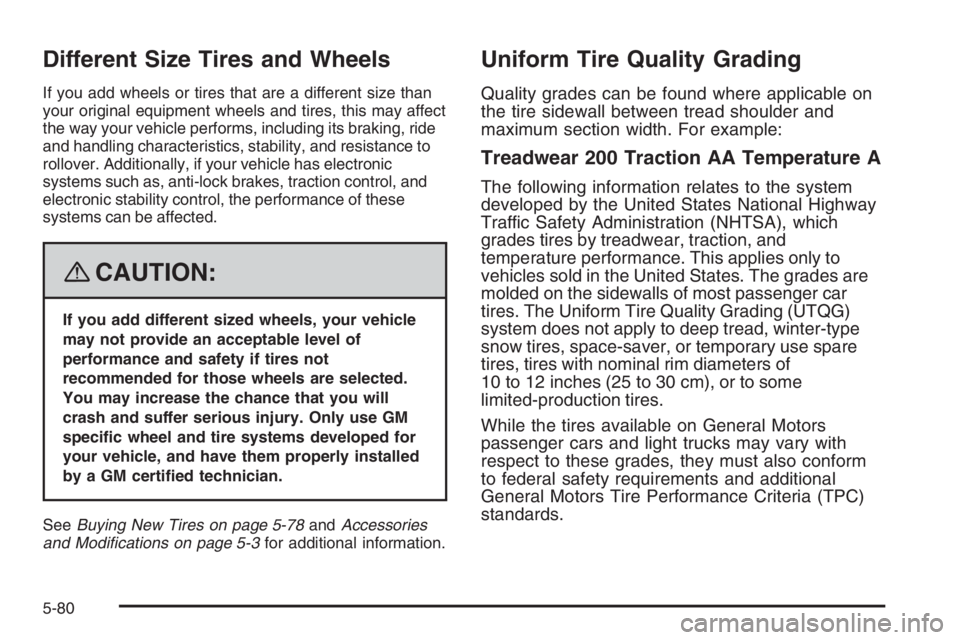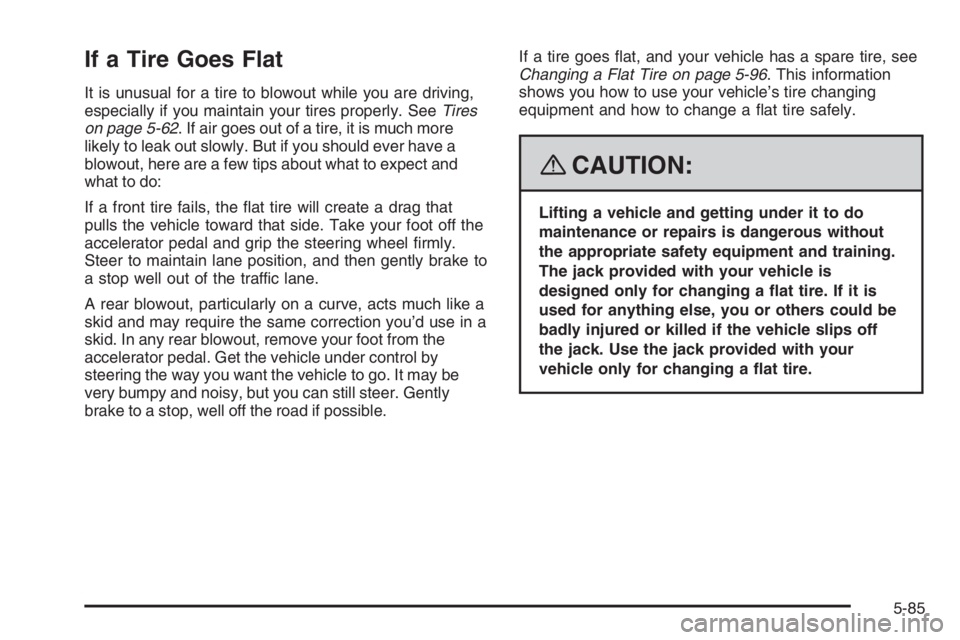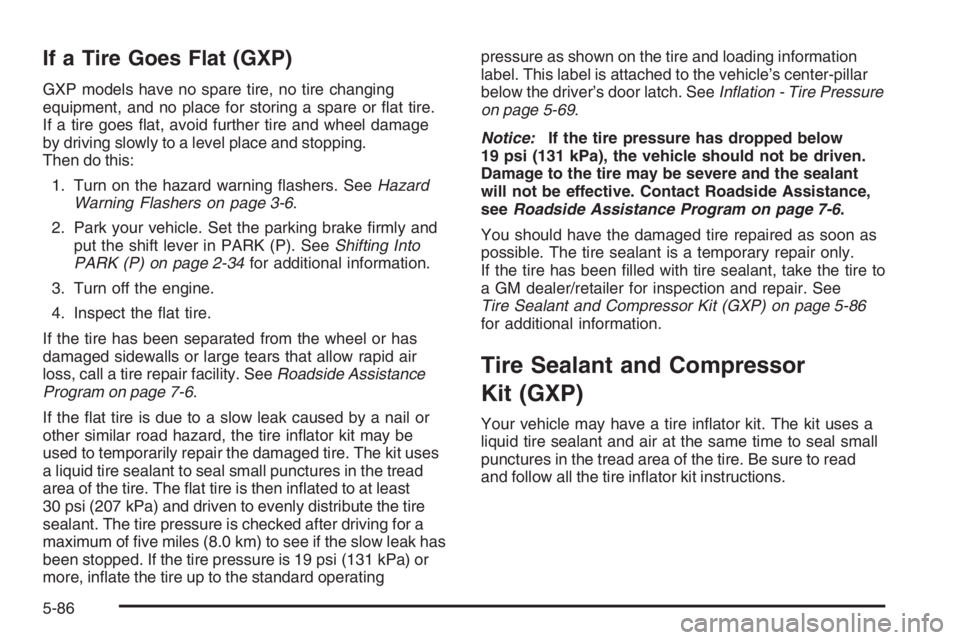Page 350 of 450

Different Size Tires and Wheels
If you add wheels or tires that are a different size than
your original equipment wheels and tires, this may affect
the way your vehicle performs, including its braking, ride
and handling characteristics, stability, and resistance to
rollover. Additionally, if your vehicle has electronic
systems such as, anti-lock brakes, traction control, and
electronic stability control, the performance of these
systems can be affected.
{CAUTION:
If you add different sized wheels, your vehicle
may not provide an acceptable level of
performance and safety if tires not
recommended for those wheels are selected.
You may increase the chance that you will
crash and suffer serious injury. Only use GM
speci�c wheel and tire systems developed for
your vehicle, and have them properly installed
by a GM certi�ed technician.
SeeBuying New Tires on page 5-78andAccessories
and Modifications on page 5-3for additional information.
Uniform Tire Quality Grading
Quality grades can be found where applicable on
the tire sidewall between tread shoulder and
maximum section width. For example:
Treadwear 200 Traction AA Temperature A
The following information relates to the system
developed by the United States National Highway
Traffic Safety Administration (NHTSA), which
grades tires by treadwear, traction, and
temperature performance. This applies only to
vehicles sold in the United States. The grades are
molded on the sidewalls of most passenger car
tires. The Uniform Tire Quality Grading (UTQG)
system does not apply to deep tread, winter-type
snow tires, space-saver, or temporary use spare
tires, tires with nominal rim diameters of
10 to 12 inches (25 to 30 cm), or to some
limited-production tires.
While the tires available on General Motors
passenger cars and light trucks may vary with
respect to these grades, they must also conform
to federal safety requirements and additional
General Motors Tire Performance Criteria (TPC)
standards.
5-80
Page 355 of 450

If a Tire Goes Flat
It is unusual for a tire to blowout while you are driving,
especially if you maintain your tires properly. SeeTires
on page 5-62. If air goes out of a tire, it is much more
likely to leak out slowly. But if you should ever have a
blowout, here are a few tips about what to expect and
what to do:
If a front tire fails, the �at tire will create a drag that
pulls the vehicle toward that side. Take your foot off the
accelerator pedal and grip the steering wheel �rmly.
Steer to maintain lane position, and then gently brake to
a stop well out of the traffic lane.
A rear blowout, particularly on a curve, acts much like a
skid and may require the same correction you’d use in a
skid. In any rear blowout, remove your foot from the
accelerator pedal. Get the vehicle under control by
steering the way you want the vehicle to go. It may be
very bumpy and noisy, but you can still steer. Gently
brake to a stop, well off the road if possible.If a tire goes �at, and your vehicle has a spare tire, see
Changing a Flat Tire on page 5-96. This information
shows you how to use your vehicle’s tire changing
equipment and how to change a �at tire safely.
{CAUTION:
Lifting a vehicle and getting under it to do
maintenance or repairs is dangerous without
the appropriate safety equipment and training.
The jack provided with your vehicle is
designed only for changing a �at tire. If it is
used for anything else, you or others could be
badly injured or killed if the vehicle slips off
the jack. Use the jack provided with your
vehicle only for changing a �at tire.
5-85
Page 356 of 450

If a Tire Goes Flat (GXP)
GXP models have no spare tire, no tire changing
equipment, and no place for storing a spare or �at tire.
If a tire goes �at, avoid further tire and wheel damage
by driving slowly to a level place and stopping.
Then do this:
1. Turn on the hazard warning �ashers. SeeHazard
Warning Flashers on page 3-6.
2. Park your vehicle. Set the parking brake �rmly and
put the shift lever in PARK (P). SeeShifting Into
PARK (P) on page 2-34for additional information.
3. Turn off the engine.
4. Inspect the �at tire.
If the tire has been separated from the wheel or has
damaged sidewalls or large tears that allow rapid air
loss, call a tire repair facility. SeeRoadside Assistance
Program on page 7-6.
If the �at tire is due to a slow leak caused by a nail or
other similar road hazard, the tire in�ator kit may be
used to temporarily repair the damaged tire. The kit uses
a liquid tire sealant to seal small punctures in the tread
area of the tire. The �at tire is then in�ated to at least
30 psi (207 kPa) and driven to evenly distribute the tire
sealant. The tire pressure is checked after driving for a
maximum of �ve miles (8.0 km) to see if the slow leak has
been stopped. If the tire pressure is 19 psi (131 kPa) or
more, in�ate the tire up to the standard operatingpressure as shown on the tire and loading information
label. This label is attached to the vehicle’s center-pillar
below the driver’s door latch. SeeInflation - Tire Pressure
on page 5-69.
Notice:If the tire pressure has dropped below
19 psi (131 kPa), the vehicle should not be driven.
Damage to the tire may be severe and the sealant
will not be effective. Contact Roadside Assistance,
seeRoadside Assistance Program on page 7-6.
You should have the damaged tire repaired as soon as
possible. The tire sealant is a temporary repair only.
If the tire has been �lled with tire sealant, take the tire to
a GM dealer/retailer for inspection and repair. See
Tire Sealant and Compressor Kit (GXP) on page 5-86
for additional information.
Tire Sealant and Compressor
Kit (GXP)
Your vehicle may have a tire in�ator kit. The kit uses a
liquid tire sealant and air at the same time to seal small
punctures in the tread area of the tire. Be sure to read
and follow all the tire in�ator kit instructions.
5-86
Page 370 of 450
Removing the Flat Tire and
Installing the Spare Tire
Your vehicle may have aluminum wheels. If so, you will
see exposed stainless steel wheel nuts. Use the wheel
wrench to loosen all the wheel nuts. Do not remove
them yet.
Or, your vehicle may have steel wheel covers.To remove the steel wheel covers and wheel nut caps,
loosen the plastic nut caps with the wheel wrench in a
counterclockwise direction. If needed, you can �nish
loosening them with your �ngers. The plastic nut caps will
not come off.
Use the �at end of the wheel wrench and pry along the
edge of the cover until it comes off. The edge of the
wheel cover could be sharp, so do not try to remove it
with your bare hands. Do not drop the cover or lay it
face down, as it could become scratched or damaged.
Store the wheel cover in the trunk until the �at tire is
repaired or replaced.
5-100
Page 371 of 450
Once you have removed the wheel cover, use the
following procedure to remove the �at tire and install the
spare tire.
1. It is recommended that you do a safety check
before preceding. SeeChanging a Flat Tire on
page 5-96for more information.
2. Set the park brake
�rmly.
3. Turn the wheel wrench
once on each wheel
nut to loosen them. Do
not remove them yet.
4. Find the jacking location located on the underside
of the rocker trim using the diagram. For jacking at
the vehicle’s front location, put the jack lift head (C)
about 6 inches (15 cm) from the rear edge of the
front wheel opening (B). Line up the jack with the
arrow (A) as shown.
5-101
Page 372 of 450
For jacking at the vehicle’s rear location, put the
jack lift head (B) about 9 inches (23 cm) from the
front edge of the rear wheel opening (C). Line up the
jack with the arrow (A) as shown.
5. Put the compact spare tire near you.
{CAUTION:
Getting under a vehicle when it is jacked up is
dangerous. If the vehicle slips off the jack you
could be badly injured or killed. Never get
under a vehicle when it is supported only
by a jack.
{CAUTION:
Raising your vehicle with the jack improperly
positioned can damage the vehicle and even
make the vehicle fall. To help avoid personal
injury and vehicle damage, be sure to �t the
jack lift head into the proper location before
raising the vehicle.
5-102
Page 373 of 450
{CAUTION:
Lifting a vehicle and getting under it to do
maintenance or repairs is dangerous without
the appropriate safety equipment and training.
The jack provided with your vehicle is
designed only for changing a �at tire. If it is
used for anything else, you or others could be
badly injured or killed if the vehicle slips off the
jack. Use the jack provided with your vehicle
only for changing a �at tire.
6. Raise the vehicle by turning the jack handle
clockwise. Raise the vehicle far enough off the
ground for the compact spare tire to attach to the
vehicle.
7. Remove all wheel nuts and take off the �at tire.
5-103
Page 374 of 450
{CAUTION:
Rust or dirt on a wheel or other parts to which
it is fastened, can make the wheel nuts
become loose and eventually the wheel could
come off and cause a crash. Always remove all
rust and dirt from wheels and other parts.8. Remove any rust or dirt
from the wheel bolts,
mounting surfaces
and spare wheel.
9. Install the compact spare tire.
5-104